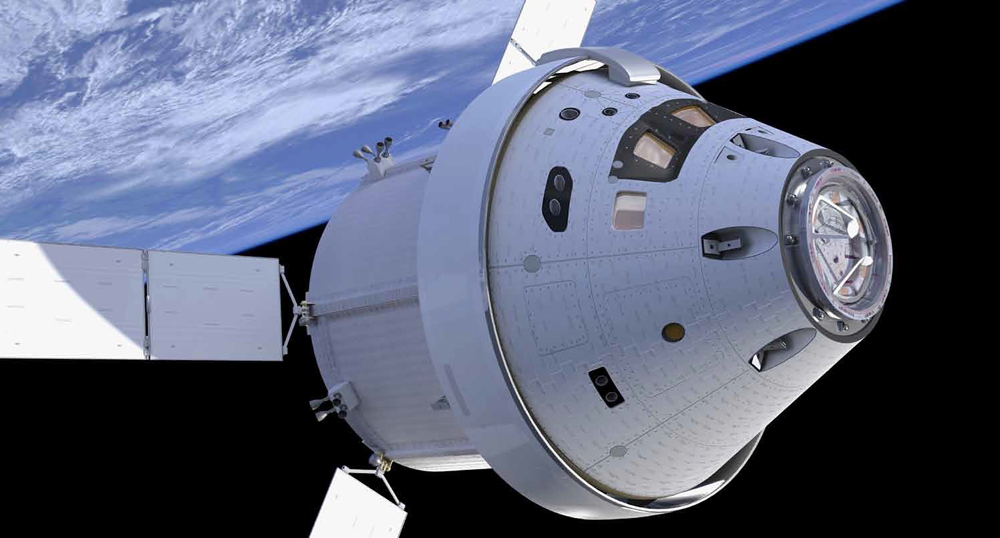
The first crewed flight of NASA's Orion spacecraft, which is being built to help humanity explore Mars and other distant destinations, may be delayed by two years, until 2023, agency officials announced today.
Orion's first crewed sojourn, known as Exploration Mission 2 (EM-2), is officially targeted for launch in August 2021. But after conducting a thorough review of the Orion program last month, NASA is now acknowledging the possibility of a delay for EM-2, saying the liftoff will occur "no later than April 2023."
Engineers and technicians are still working toward the August 2021 goal, but hitting that target is unlikely, said NASA Associate Administrator Robert Lightfoot. [The Orion Capsule: NASA's Next Spaceship (Photos)]
"It's not a very high confidence level, I'll tell you that, because of the history — the things we see historically pop up," Lightfoot told reporters during a teleconference today (Sept. 16). Such factors include complications arising from the reuse of equipment from flight to flight and software development, he added.
"We're not seeing any issues in those areas, but we have to account for those, because we have a lot of runway in front of us," Lightfoot said.
NASA is developing Orion, which can support a crew of four for up to 21 days, as well as a megarocket called the Space Launch System (SLS) to enable the crewed exploration of deep space. The capsule will get astronauts to space and back to Earth, and it will carry them on missions in Earth-moon space. (Long journeys, such as the trek to Mars, will feature habitat modules for crewmembers to live in.)
"Orion is a predominant, first key player in really allowing us to move human presence out of low Earth orbit," said Bill Gerstenmaier, associate administrator for NASA's Human Exploration and Operations Directorate.
Get the Space.com Newsletter
Breaking space news, the latest updates on rocket launches, skywatching events and more!
Orion blasted off for the first time last December, riding a United Launch Alliance Delta IV Heavy rocket on a successful unmanned mission called Exploration Flight Test 1 (EFT-1). SLS won't reach space until 2018, when it sends an uncrewed Orion winging around the moon on the weeklong Exploration Mission 1 (EM-1).
EM-2's destination and duration aren't finalized yet, but Orion will carry astronauts on the mission. Indeed, the main goals include making sure that the capsule's crew systems are ready to perform in deep space. The next flight after that, Exploration Mission 3 (EM-3), could be pretty much an operational flight; it may send astronauts out to rendezvous with a chunk of a near-Earth asteroid that a robotic probe has delivered to lunar orbit. (NASA wants this asteroid visit to take place by 2025.)
A possible delay for EM-2 won't necessarily affect the schedules for either EM-1 or EM-3, Lightfoot and Gerstenmaier said.
NASA will spend $6.77 billion to get Orion ready for EM-2, from October 2015 through the mission's completion, Lightfoot said. A commitment of more funding could conceivably allow the agency to accelerate EM-2's schedule, he added.
And some lawmakers would like more money for Orion and SLS — including Rep. Lamar Smith, R-Texas, chairman of the House of Representatives' Science, Space, and Technology Committee.
"Once again, the Obama administration is choosing to delay deep-space exploration priorities such as Orion and the Space Launch System that will take U.S. astronauts to the moon, Mars and beyond," Smith said in a statement today in response to news of the possible EM-2 delay.
"We must chart a compelling course for our nation's space program so that we can continue to inspire future generations of scientists, engineers and explorers," Smith said. "I urge this administration to follow the lead of the House Science, Space and Technology Committee's NASA Authorization Act to fully fund NASA's exploration programs."
Follow Mike Wall on Twitter @michaeldwall and Google+. Follow us @Spacedotcom, Facebook or Google+. Originally published on Space.com.
Join our Space Forums to keep talking space on the latest missions, night sky and more! And if you have a news tip, correction or comment, let us know at: community@space.com.

Michael Wall is a Senior Space Writer with Space.com and joined the team in 2010. He primarily covers exoplanets, spaceflight and military space, but has been known to dabble in the space art beat. His book about the search for alien life, "Out There," was published on Nov. 13, 2018. Before becoming a science writer, Michael worked as a herpetologist and wildlife biologist. He has a Ph.D. in evolutionary biology from the University of Sydney, Australia, a bachelor's degree from the University of Arizona, and a graduate certificate in science writing from the University of California, Santa Cruz. To find out what his latest project is, you can follow Michael on Twitter.









